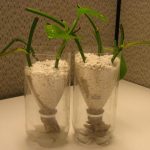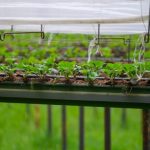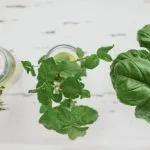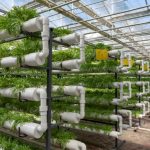Wick system hydroponics is a simple and beginner-friendly method for growing plants without soil. As the most basic form of hydroponics, it’s an excellent way to dip your toes into the world of soilless gardening without being overwhelmed by complex systems and techniques. Its passive nature, with no moving parts, ensures that you can focus on the essentials of hydroponics while still gaining valuable experience.
In a wick system, plants are nourished by a water-based nutrient solution that’s fed directly to their roots through wicks. This uncomplicated design consists of four primary components: a growing container, growing medium, wicks, and a nutrient solution reservoir. By taking advantage of the wicking action, your plants receive the necessary nutrients for growth without the need for pumps or other mechanical parts.

As you embark on your journey into wick system hydroponics, remember that this is just the beginning of your soilless gardening adventures. With a foundation in this straightforward method, you’ll be well on your way to exploring other hydroponic systems and methodologies as your skills develop. So, roll up your sleeves, and let’s get started on creating your very own wick system hydroponic garden.
- How Does A Wick Hydroponics System Work?
- Hydroponic Wick System Materials and Components
- Growing Media for a Wicking System
- Choosing Suitable Wick System Plants
- Wick System Benefits and Drawbacks
- How To Build A Wick Hydroponic System DIY
- Wick System Strategies and Tips
- Maintaining a Wick System Hydroponics
- Troubleshooting Common Issues in Wick System for Hydroponics
How Does A Wick Hydroponics System Work?
A wick system of hydroponics is a simple, efficient, and cost-effective technique that allows you to grow your plants without soil. It relies on wicks to deliver water and nutrients from a reservoir to your plants’ roots through capillary action. The system is passive, so you won’t need any motors or pumps for it to work.
In a wick system, you begin by setting up four main components: the grow tray, reservoir, wick, and an optional aeration system. The grow tray will hold the plants and their growing medium. Instead of using net pots, you’ll place the growing medium directly in the tray. You’ll then plant your seedlings in the medium, ensuring that their roots have enough space to grow and develop.
The reservoir, which will store your nutrient solution, should be placed beneath the grow tray. This is where the wick comes in handy; using two or more wicks, you’ll connect the reservoir to the grow tray. These wicks work as the “bridge” between your plants’ roots and the nutrient solution, effectively delivering the essential nutrients your plants need to grow.
For the nutrient solution, you’ll need to mix water and a balanced hydroponic nutrient mix. This mix contains the macronutrients and micronutrients your plants need to grow and thrive. While you don’t require a pump in a wick system, you can still use an aeration system to enhance the dissolved oxygen content in the nutrient solution.
It’s crucial to choose the right plants for your wick hydroponics system, as not all plants will thrive in this setup. Some plants that do well in wick systems include lettuces, herbs, pak choi, and certain indoor plants.
Overall, a wick hydroponics system is an excellent choice for beginners and those seeking a low-maintenance, cost-effective option for growing plants. Just make sure to monitor the nutrient levels in your reservoir and replace them as needed to keep your plants healthy and productive.
Related: The wick method isn’t the only passive type of hydroponics. There’s also the Kratky method.
You can learn about the various types of hydroponic systems in our comprehensive guide on hydroponics.
Hydroponic Wick System Materials and Components
In the wick system, you will primarily need a growing container, a reservoir for nutrient solution, a growing medium, and wicks. The wicks, usually made from an absorptive hydroponic wick material, play a crucial role in transporting water and nutrients to the plant’s roots through capillary action.
To set up your hydroponic wick system, start by choosing a suitable container for your plants. This container will hold the growing medium, so make sure it’s spacious enough for both the roots and the medium. Common options include plastic storage containers or large gardening pots.
Next, you’ll need a reservoir to hold the nutrient solution. This reservoir will sit underneath the main growing container and supply water and nutrients via the wicks. Keep in mind that you’ll need a cap or lid with holes to accommodate the wicks, which will dip into the reservoir.
For the wicks themselves, you can choose from various materials such as rope, felt, or cotton or nylon strips. However, it’s essential to use a material that can effectively conduct water, allowing capillary action to distribute water from the reservoir to the growing medium and eventually to the roots.
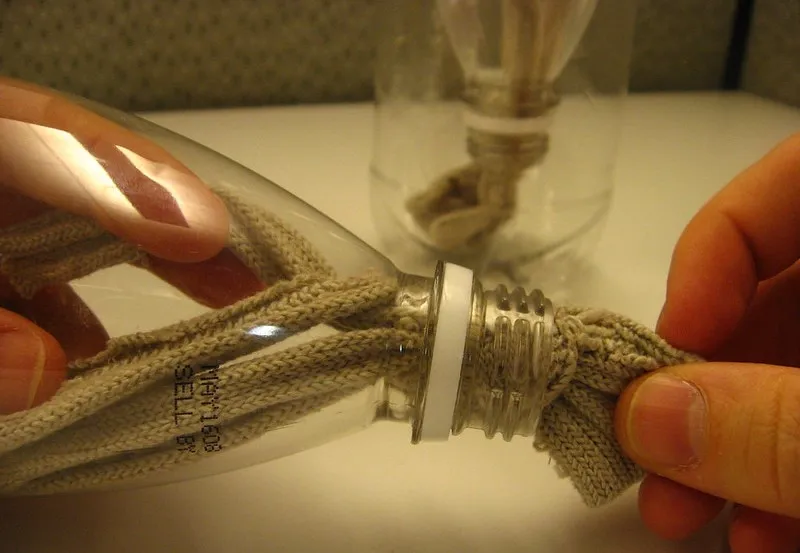
There are several options available, such as:
- Fibrous rope: An excellent choice for a wick, as it offers an adequate capillary action. This can be helpful if you decide to grow herbs or other plants that can’t be overwatered.
- Propylene felt strips: These are ultra-absorbent and can provide a constant supply of moisture, making them another great option as a wick material for your hydroponic system.
- Tiki torch wicks: A household item that can serve as an efficient wick for smaller hydroponic setups.
- Rayon rope: Known for its effectiveness in wicking water and being easily available, this is another good option for your wick system.
- Mop head strands: You can recycle old mop heads by utilizing their strands as effective wick materials.
Now, you’ll need to select a growing medium for your plants. Popular choices for a hydroponic wick system include coconut coir, perlite, and vermiculite. Each medium has different properties, so choose one that suits the specific needs of your plants. For example, herbs typically thrive in a well-draining medium like perlite.
To sum up, assembling your hydroponic wick system involves these key materials and components:
- Growing container
- Reservoir with a cap or lid
- Wicks made from a suitable hydroponic wick material
- Appropriate growing medium
Ensure proper positioning of the wicks to prevent issues such as root rot by providing good contact between the wicks, medium, and roots. With the right materials and setup, your hydroponic wick system will ideally help your plants grow healthy and strong through efficient nutrient and water uptake.
Growing Media for a Wicking System
When selecting a growing medium for your wick system hydroponic garden, considering moisture retention and effective utilization of the capillary action of the wick is essential. The ideal growing medium should not drain too fast and allow for proper aeration of the plant roots. A mix consisting of 60% perlite and 40% vermiculite is a great option.
Perlite, being relatively loose, enables rapid root growth for your plants, while its lower water-holding capacity compared to vermiculite helps prevent the medium from retaining excessive moisture. Vermiculite has an excellent ability to absorb water and nutrients, making it a perfect medium for wick hydroponics where the nutrient solution is drawn up into the root zone.
Coco coir is another viable choice for wick system hydroponics, thanks to its excellent water retention capabilities and ability to maintain adequate air pockets. It works well in conjunction with perlite, as the mix can strike a balanced moisture level for your plants.
Remember to structure your wick system hydroponic garden in a way that ensures proper aeration of the plant roots. Including an air stone can significantly help in oxygenating the water, maintaining healthy root systems, and consequently promoting optimal growth.
Using the right combination of growing media and materials, you can successfully cultivate a thriving wick system hydroponic garden with flourishing plants. Keep in mind the different moisture requirements and adapt your setup accordingly to cater to your chosen plant types.
Choosing Suitable Wick System Plants
When selecting plants for your wick system hydroponics, it’s essential to choose ones that will thrive in this environment. Wick systems work well for plants that don’t require a lot of water or have smaller root systems.
Seedlings can benefit from a wick system as they acclimate to growing in a hydroponic environment. Excellent examples of suitable plants are lettuces and herbs such as rosemary, which will quickly grow in this system due to their modest water requirements. They are ideal for growing in a wick system, as the system’s method of providing nutrients via capillary action works well for these types of plants. In contrast, the wick system may not be suitable for plants that require an actively flowing nutrient solution. These include root vegetables, fast growers, or heavy feeders. Other hydroponic systems could better support these plants’ needs.
By carefully selecting the plants and wick materials for your system, you can create a thriving hydroponic garden. It’s always good to experiment with new plants and materials to find what works best for you and your plants.
Wick System Benefits and Drawbacks
Wick hydroponics, a passive system without the use of pumps or electricity, offers several advantages. It’s simple to set up even at home, cost-effective, and low maintenance – ideal for beginners in hydroponic gardening. The system uses wicks to deliver nutrients directly from the solution to the plant roots, reducing water usage compared to traditional farming methods.
On the downside, wick systems may not be suitable for larger plants or those with high nutrient demands as they might struggle to provide adequate hydration and nutrition in sufficient quantity. Also, there’s a potential risk of root diseases due to over-saturation if not monitored carefully. Go deeper into wick system hydroponics pros and cons here.
How To Build A Wick Hydroponic System DIY
Building a hydroponic wick system DIY can be quite easy, even for beginners. This passive system is perfect for beginners as it doesn’t rely on pumps or timers and works well for smaller plants. Here’s a step-by-step guide to help you construct your own wick system at home.
Take a look at this wick system hydroponics diagram:
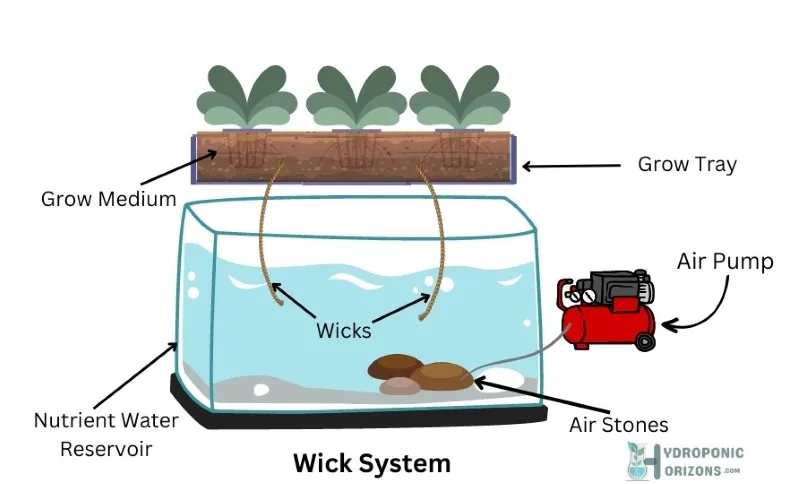
Step 1: Gather your components For your DIY wick system, collect the following components:
- A reservoir tank (such as a plastic container or a soda bottle)
- A growing tray
- Growing medium (like vermiculite or perlite)
- Nylon rope or string for the wick
- Nutrient solution
- Oxygen source (such as an air stone)
- Plants or seeds
Step 2: Prepare your reservoir and tray First, clean your reservoir tank thoroughly. Decide on the layout of your system, making sure the growing tray is placed above the reservoir. If using a soda bottle, cut the top off and invert it to act as the growing tray. Drill holes into the bottom or sides of the growing tray, or make sure the tray has slits or channels so excess water can flow back to the reservoir.
Step 3: Set up the wick Cut the nylon rope or string into pieces, long enough to reach from the bottom of the reservoir to the growing tray. Thread each piece through the holes you drilled in the tray, ensuring they reach the nutrient solution in the reservoir when it’s filled. The wick will use capillary action to draw the nutrient-rich water up to the plant roots in the growing tray.
Step 4: Add the growing medium and plants Fill the growing tray with your chosen growing medium, ensuring that it provides ample air and water retention. Plant your chosen crops, such as rosemary or other small plants, directly into the medium. Make sure the wicks are in direct contact with the growing medium and the plant roots.
Step 5: Fill the reservoir with the nutrient solution Mix the nutrient solution according to the manufacturer’s instructions and fill the reservoir. Ensure the wick is adequately submerged in the solution to draw it up to the plant roots.
Step 6: Add oxygen to the reservoir Place an air stone connected to an air pump in the reservoir to provide the necessary oxygen for your plants’ root development. If a pump is not available, regularly agitate the solution gently to help oxygenate it.
Remember to monitor the system, checking the nutrient levels and pH balance and refilling the reservoir when necessary. Keep an eye on your plants and adjust the environment accordingly to prevent issues like mold growth.
Wick System Strategies and Tips
In a wick system hydroponic garden, it is essential to select the right wicking material and ensure proper setup. Here are some friendly tips to help you optimize your hydroponic system:
- Choosing wicking material: Select an absorbent and durable material for your wicks. Cotton rope is a popular choice as it is efficient in transferring water and nutrients from the reservoir to your plants’ roots.
- Measuring and cutting wicks: Measure the length of the wick to ensure it reaches from the grow tray to the reservoir, with a little extra on both ends. Cut the wicks accordingly and ensure there are enough wicks for all your plants.
- Securing the wicks: Drill small holes at the bottom of your grow tray for the wicks to pass through. Make sure the holes are large enough for the wicking material but small enough to prevent the growing medium from falling into the reservoir.
- Ensuring active wicking: Proper wicking is crucial for the success of your hydroponic system. Make sure the wicks stay submerged in the nutrient solution to continuously supply water and nutrients to your plants.
- Selecting suitable plants: Wick systems work best with plants that have moderate nutrient requirements. Tomatoes, for instance, might not be the best choice since they tend to be heavy feeders. Opt for plants with smaller nutrient needs, and observe your plants closely to ensure they are getting the required nutrients.
- Monitoring and maintaining: Keep an eye on the water level and nutrient concentration in your reservoir. Regularly top up the reservoir with water and nutrients to maintain optimal conditions for your plants.
By following these tips and regularly monitoring your wick system hydroponic garden, you can ensure your plants thrive and enjoy a successful growing experience.
Maintaining a Wick System Hydroponics
Maintaining your hydroponic wick system is essential to ensure your plants grow healthily and efficiently. As a beginner, the wick system is an excellent choice, as it is among the simplest types of hydroponic systems to maintain.
To prevent your plants from rotting, regularly check your wick system for proper functioning. If you notice discolored or slimy roots, it’s a sign of poor air circulation or excess moisture, which can lead to root rot. To address these issues, consider adding an air pump to your reservoir to improve oxygenation and circulation. Alternatively, consider using a more porous growing medium like perlite or coco coir, which allows for better air circulation around the plant roots.
Maintaining an ideal nutrient balance is crucial to the success of your hydroponic wick system. Keep an eye on the nutrient solution levels in the reservoir and top it up as needed. Over time, the nutrient concentrations might become too strong or dilute, so it’s essential to occasionally replace the entire solution. Monitor the pH levels as well, aiming for a range of 5.5 to 6.5, depending on the plants you’re growing.
Unlike active hydroponic systems, wick systems don’t have an automated watering cycle. Therefore, you’ll need to keep a close watch on the growing medium’s moisture levels. Ensure that the wick material stays in contact with the nutrient solution at all times.
Troubleshooting Common Issues in Wick System for Hydroponics
Sometimes, you may encounter issues in your wick system hydroponic setup. Here are a few common problems and their solutions to help you keep your garden thriving:
- Root Problems: Over-watering in a grow tray can lead to root problems. Ensure that your wick system is functioning correctly, and consider using an air stone to oxygenate the water, keeping the roots aerated and healthy.
- Nutrient Deficiencies: You might notice that your plants are not growing as well, or they have unusual colors, indicating a nutrient deficiency. Check for any wicks that may be clogged or damaged and replace them if necessary. Be sure to use a balanced nutrient solution that provides all essential nutrients for your plants.
- Inadequate Capillary Action: If you notice your plants are wilting or drying out, it could be due to inadequate water uptake through the wick. To solve this, choose a more effective wicking material or a grow medium with better water retention such as a blend of perlite, hydroton, coco coir, or vermiculite. Make sure your wicking material is thoroughly saturated with nutrient solution, and adjust the length of the wicks if necessary to optimize water delivery.
Remember to monitor your wick system hydroponics regularly and address any issues as they arise. By doing so, you will maximize the health and growth of your plants.

